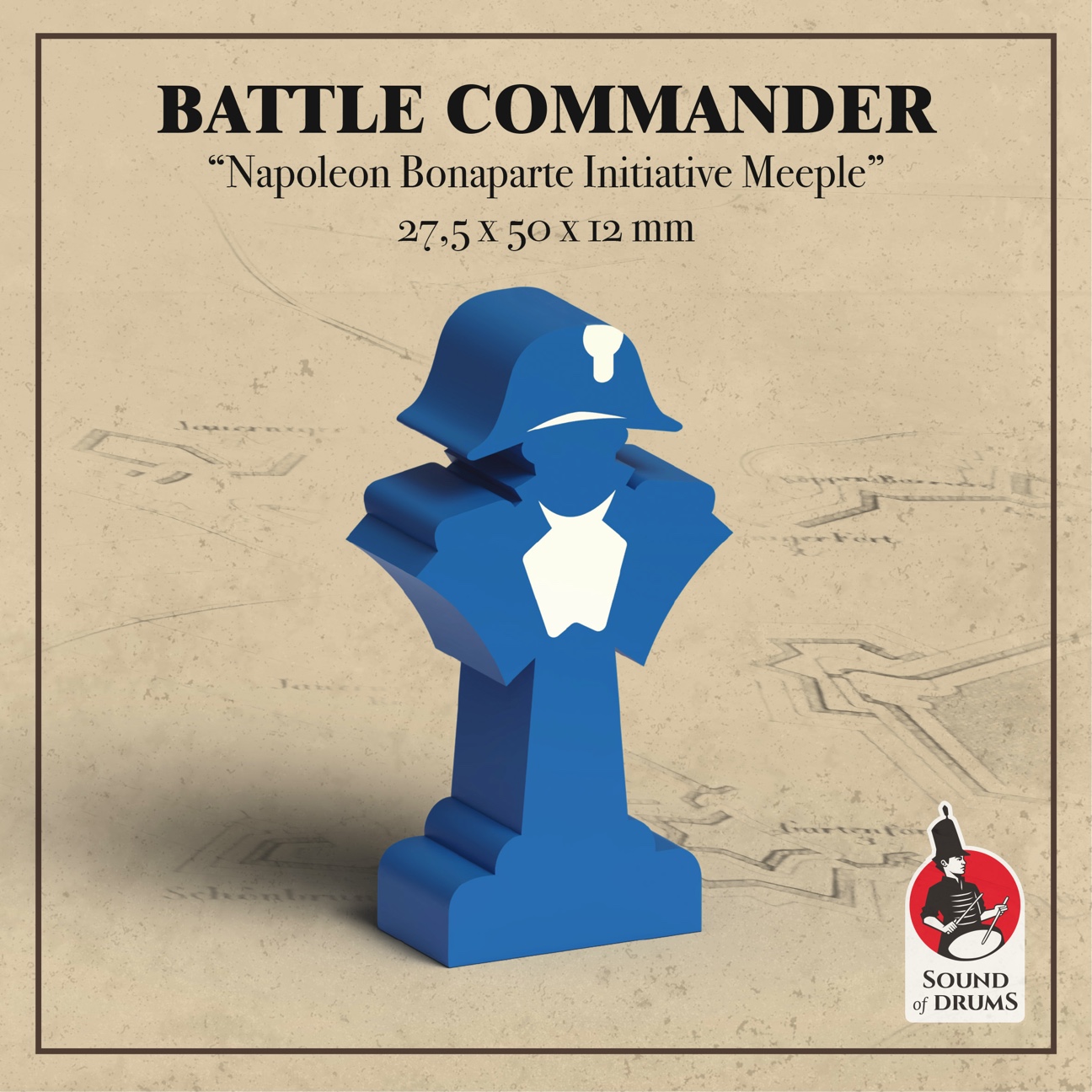| Designed by Carl Paradis, “Battle Commander Vol 1” uses many innovative game concepts, and will bring brisk and original wargame play to your gaming table. | | Read here the fascinating designer's thought about this new concept: | | After spending many years covering WW2 Campaigns, I decided to tackle my all-time favorite military period: the Napoleonic Wars. As with my previous works, the spark was a mild disappointment with most other designs covering this captivating epoch. I created a new-fangled grand-tactical system to showcase my own “grognard” take of how such momentous military engagements should be represented on your gaming table, putting emphasis on dynamic gameplay and historical pageantry. I hope you’ll enjoy the first Volume of this new series and glamour for more: I’ll readily answer the call! | | The First step was to create the game’s components with a distinctive “period feel”, using painted-on wood blocks, a new map grid system effortlessly managing historical formation intervals, and stylish graphics: the package harks back to the 19th century “Kriegspiel” wargames’ appearance, mimicking a contemporary Napoleonic battle maps’ look, instead of a pure hex & counter affair more attuned to modern-era operational conflicts. | Second step was to build a simulation engine that depicts the correct historical battle dynamics in a way to make the gameplay as effortless as possible for the gamers.
Block count was kept low, with about the same number of maneuver elements as in chess; combat resolution computations are sparse and mechanics kept simple: this allows players to focus on strategy, not wasting precious match time working as glorified accountants. Emphasis is put on the army commanders’ decision points, planning, battlefield maneuvering, resource management, morale and skill. You play the game, it does not play you! | | Third step was to have it all tailored to work in a dynamic, brisk and interactive manner. For this I chose a cube-pull activation mechanic that trigger all game happenstances: movement, combat, rally, card draws, turn end, etc. This lowers play downtime to naught: you won’t wait unduly before being able to do interesting actions, as it’s all very granular. The luck of the draw will add a good dose of realistic gameplay chaos, and makes the game very solitaire-friendly; with the card events adding another layer of drama and possibilities: this is not a “flat” game! | | It’s All About Simulation | | Fourth Step was to deliver an accurate yet manageable conflict model. For this purpose no dice were used, as the card deck allows for a seamless integration of dozens of different combat result tables, making for a very refined probability system that avoids convoluted computations. The degradation of the Armies’ fighting abilities demand no roster sheets, casualty markers, or the elimination of scores of counters. Like the real thing, most units will at first keep their cohesion, engaging reserves to keep battle lines manned, until their army’s morale starts to disintegrate; but on occasion catastrophic losses can and will happen. The game board will look pretty much like a Napoleonic battle map; when things go bad, you’ll literally feel the enemy pressure, your Army slowly falling apart... All this simulated in an easy to play format. | -
But let’s talk about combat: there are two main types of Attacks, Assault and Fire. As told in the rules, Assault also represent close-range fire, and more importantly a very aggressive battle stance meant to push the enemy out of its positions and break his will to fight; while Fire is a more stolid strategy, aimed at wearing down the | | opposition with low risk for the attackers. | | Fifth and last step was to make the darn thing a fun, carousing experience. You have to prepare for chaos, and chaos will happen all right! The great variety of event cards, hassle-free mechanics, friction tables, fast movement and dynamic combat mean that you’ll rarely experience boring play downtimes. I design games that I want to play, and play often: this series is no exception; it’s a game-player affair, but without compromising history. | | I labored intently for many, many years so to make the game your hold in your hands as realistic as possible without burdening the participants with complex and time- consuming mechanics. Scores of Battles were studied, some were even gamed using my Napoleonic miniatures house rules to validate the order and combat engines. | -
This led to some interesting discoveries, like the fact that most units engaged in battle often stayed immobile for extended periods of time, waiting for orders. This allowed me to simplify the movement rules without any adverse simulation results. Armies will have their own inertia, and once committed, it’ll be difficult to change the course of action, so ponder your battle plan carefully! | | The casualty rates in most of these battles were quite an eye-opener too, being generally around 20% of a force, major units generally staying “in the field” until the army “breaks”. The card-managed combat system, tested many thousands of times, gives a surprisingly good rendition of weapons’ effects over the course of a Battle. | | It’s All About the Future | | If well-received, I plan to continue the series until the majority of the appealing Napoleonic engagements are covered, putting emphasis on battles fought by Napoléon Bonaparte. Most will be done in chronological order, but I might “time travel” now and then, for example covering the Waterloo campaign before the end of the series. | -
Speaking of series, the game engine was purposefully designed to cover other “Black Powder” periods, like the Seven-Years War, American Civil War, and even some Thirty-Years War battles: as long as you, the customer, want them, “Sounds of Drums” will deliver! | | Carl Paradis Québec, Canada. | | We are available 24/7 for you. | |




Add comment